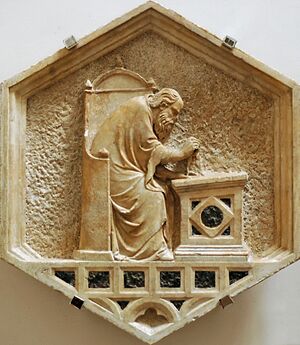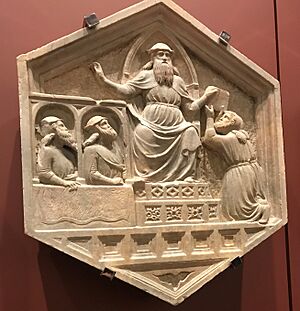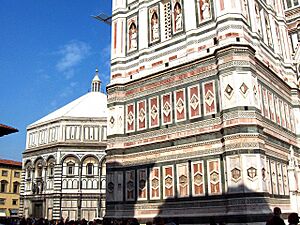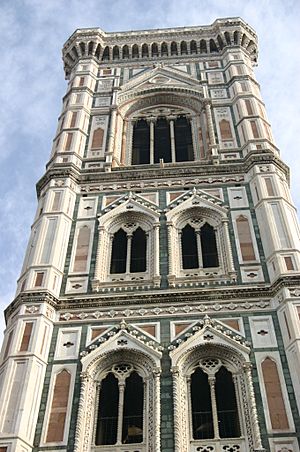Giotto's Campanile facts for kids
The Giotto's Campanile is a tall, free-standing bell tower in Florence, Italy. It is part of the famous Florence Cathedral complex in the Piazza del Duomo. This amazing tower stands next to the Basilica of Santa Maria del Fiore and the Baptistry of St. John. It's a beautiful example of Florentine Gothic architecture. The tower was designed by the famous artist Giotto. It is known for its detailed sculptures and colorful marble decorations.
The tower is square at its base, measuring about 14.45 meters (47 feet) on each side. It stands 84.7 meters (278 feet) tall. The tower has strong supports called buttresses at each corner. It is divided into five main sections, or "stages," as you look up.
Contents
History of the Bell Tower
After the first architect of the Cathedral, Arnolfo di Cambio, passed away in 1302, work on the tower stopped for over 30 years. Then, in 1334, the famous painter Giotto di Bondone was chosen to take over. He was 67 years old at the time. Giotto focused all his energy on designing and building the bell tower for the cathedral.
Giotto started building on July 19, 1334. He wanted the tower to match the colorful look of the cathedral. He used different colored marbles to create geometric patterns. These included white marble from Carrara, green marble from Prato, and red marble from Siena.
When Giotto died in 1337, only the first floor was finished. This lower floor is decorated with special bas-reliefs. These are carvings that stick out from the surface. There are seven hexagonal (six-sided) panels on three sides. Later, two panels were moved to the empty north side. Five more panels were added in 1437 by Luca della Robbia. The number "seven" is important in the Bible, symbolizing human progress.
It's hard to say exactly who made all these panels. Some might be by Giotto himself, while others were likely made by Andrea Pisano or his assistants. Giotto's work on this tower helped make him one of the founders of Italian Renaissance architecture.
Who Continued the Work?
After Giotto, Andrea Pisano took over in 1343. He was already famous for making the South Doors of the Baptistery. Pisano continued building the bell tower, carefully following Giotto's plans. He added a second section above Giotto's first floor. This section has diamond-shaped panels called lozenges.
Pisano also built two more levels, each with four empty spaces for statues. However, construction stopped in 1348 because of the terrible Black Death plague.
Francesco Talenti then became the new Master of the Works in 1348. He built the top three levels of the tower. These levels have large windows. Talenti finished the bell tower in 1359. Giotto had planned for a tall spire on top, but Talenti did not build it. This made the tower shorter than Giotto's original idea. It ended up being 84.7 meters (278 feet) tall instead of 122 meters (400 feet).
You can climb 414 steps to reach the top of the tower. From there, you get an amazing view of Florence and the hills around it!
Amazing Artworks
All the artworks you see on the campanile today are copies. The original pieces were moved between 1965 and 1967. They are now kept safe in the Museo dell'Opera del Duomo, which is a museum behind the cathedral.
The Hexagonal Panels
The hexagonal panels on the lowest level tell the story of humankind. They are inspired by the Bible's book of Genesis.
- On the west side, they show the creation of man and woman. This includes the Creation of Adam, Creation of Eve, and the first work of our early parents.
- They also show the beginnings of "mechanical arts" and "creative arts." These include Jabal (raising animals), Jubal (music), Tubalcain (first blacksmith), and Noah (first farmer). This story continues on the south and east sides of the tower.
Most of these Genesis panels are thought to be by Andrea Pisano. However, the "Jubal" panel is by Nino Pisano, and "Tubalcain" is by an assistant of Andrea Pisano.

The seven hexagonal panels on the south side show different skills and ideas. These include Astronomy, Building, Medicine, Hunting, Wool-working, Lawmaking (Phoroneus), and Flight (Daedalus). Most are by Andrea Pisano, but some are by his workshop or Nino Pisano.
The east side has only five panels because of the entrance door. These show important "liberal arts" like Navigation, Social Justice, Agriculture, Art of festivals, and Architecture (Euclid). The first three are by Andrea Pisano, and the last two are by Nino Pisano.
The north side hexagonal panels show: Sculpture, Phidias (moved from the east side), Painting, Harmony, Grammar, Logic and Dialectic (Plato and Aristotle), Music and Poetry (Orpheus), Geometry and Arithmetic (Euclid and Pythagoras). The first two are by Andrea Pisano and Nino Pisano. The others are by Luca della Robbia.
The Lozenges
The lozenges are on the next level up. They have a different style, with marble figures standing out against a blue background. Most of these symbolic artworks are by Andrea Pisano or his school.
- The west side shows the Planets: Saturn, Jupiter, Mars, the Sun, Venus, Mercury, and the Moon.
- The south side shows the three Theological and four Cardinal Virtues: Faith, Charity, Hope, Prudence, Justice, Temperance, and Fortitude.
- The east side shows the seven "Liberal Arts": Astronomy, Music, Geometry, Grammar, Rhetoric, Logic, and Arithmetic.
- The north side shows the Seven Sacraments. These are shown realistically and include Baptism, Confession, Matrimony, Holy Order, Confirmation, the Eucharist, and the Extreme Unction. Most are by Maso di Banco.
The Statues in the Niches
On the next level, each side has four statues placed in special spaces called niches. These statues were made at different times.
- The four statues on the west side were carved by Andrea Pisano around 1343. They show the Tiburtine Sibyl, David, Solomon, and the Erythraean Sibyl.
- The four Prophets on the south side were made between 1334 and 1341. They have a more classic style. The statue of Moses and the fourth statue are by Maso di Banco.
- The four Prophets and Patriarchs on the east side were made between 1408 and 1421. These include the beardless Prophets by Donatello (possibly a portrait of his friend, Filippo Brunelleschi). There is also the Bearded Prophet (perhaps by Nanni di Banco), Abraham and Isaac (by Donatello and Nanni di Banco), and Il Pensatore (the thinker) by Donatello.
- The four statues on the north side were added between 1420 and 1435. These include a Prophet (likely by Nanni di Banco), Habacuc (a famous work by Donatello), Jeremias (by Donatello), and Abdias (by Nanni di Banco).
The Top Three Levels
Francesco Talenti built these top levels between 1348 and 1359. Each level is slightly larger than the one below it. This clever design makes them look like they are the same size when you view the tower from below. The tall, narrow windows on these levels were inspired by the bell tower in Siena. Instead of a pointed spire, Talenti built a large flat terrace at the very top.
The carvings, statues, and decorations on the tower all work together. They tell a story based on medieval ideas and beliefs.
The Bells
Giotto's Campanile has seven bells. Here is a list of them:
| No. | Name | Year of casting | Founder | Diameter (mm) |
Weight (kg) |
Note |
|---|---|---|---|---|---|---|
| 1 | Campanone | 1705 | Antonio Petri, Florence | 2000 | 5385 | A2 |
| 2 | La Misericordia | 1808 | Carlo Moreni | 1520 | ~2100 | C3 |
| 3 | Apostolica | 1957 | Fonderia Barigozzi | 1250 | 1200 | D3 |
| 4 | Annunziata | 1956 | Fonderia Barigozzi | 1150 | 856.5 | E3 |
| 5 | Mater Dei | 1956 | Fonderia Barigozzi | 950 | 481.3 | G3 |
| 6 | L'Assunta | 1956 | Fonderia Barigozzi | 850 | 339.6 | A3 |
| 7 | L'Immacolata | 1956 | Fonderia Barigozzi | 750 | 237.8 | B3 |










